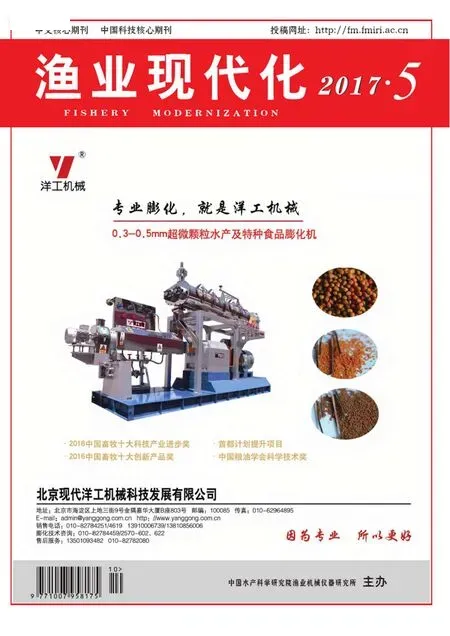聚己内酯添加量对淡水养殖水体硝酸盐氮处理效果的影响
侯志伟, 高锦芳, 罗国芝,2
(1上海水产养殖工程技术中心,上海海洋大学, 上海 201306; 2 农业部淡水水产种质资源重点实验室,水产科学国际级实验教学示范中心,上海海洋大学,上海 201306)
聚己内酯添加量对淡水养殖水体硝酸盐氮处理效果的影响
侯志伟1, 高锦芳1, 罗国芝1,2
(1上海水产养殖工程技术中心,上海海洋大学, 上海 201306; 2 农业部淡水水产种质资源重点实验室,水产科学国际级实验教学示范中心,上海海洋大学,上海 201306)

聚己内酯;固相反硝化;循环水养殖系统;硝酸盐氮


1 材料与方法
1.1材料
试验所用PCL颗粒采购自深圳市光华伟业实业有限公司,为白色结晶性米状颗粒,平均大小为2~3 mm,主要力学性能参数:密度1.12 kg/L,分子量 80 000,熔融指数1~4 g/10 min,熔点58℃~60℃,断裂伸长率800%。试验开始前清洗PCL以去除杂质,在35℃下烘干至恒重。
1.2试验设计

1.3水质测定方法
1.4显微镜观察
取未使用和使用后的PCL颗粒,清洗后固定在铝制圆盘上,真空条件下在其表面喷金,利用电子扫描显微镜(S3400NII,日立有限公司,日本)进行扫描观察并拍照。
1.5去除效率和去除率计算

RE=100%×(C进-C出)/C进
(1)

RR=(C进-C出)×Q/V
(2)

RA=RR×V×t
(3)

1.6PCL利用率计算
实验结束后将PCL在超声波振荡器(KQ2200E,昆山超声波仪器有限公司)中清洗,使生物膜与PCL完全剥离,清洗后的PCL在35℃下烘干称重。根据公式4计算各添加量的PCL利用率。
UR=100%×(W始-W末)/RA
(4)
式中:UR—PCL利用率,%;W始—实验开始时PCL的质量,kg;W末—实验结束时PCL的质量,kg。
1.7数据分析
所有数据用 SPSS 17.0(SPSS, Inc., Chicago, IL, USA)分析。各种PCL添加量指标采用单因素方差分析方法(ANOVA) 。差异显著性用Tukey 检验,P<0.05为差异显著。
2 结果与分析


图1 各组进出水硝酸盐氮浓度Fig.1 Concentrations of nitrate nitrogen
试验结束时,各组PCL的消耗量见图2。消耗量5 g组最少,且5 g组与其余三组差异显著,25 g组最大,10、15和20 g组和15、20、25和30 g组消耗量均无显著性差异。

图2 试验结束时各组PCL的消耗量Fig.2 Consumptions of PCL at the end of in the influent water for each group the experiment for each group

表1 试验条件下去除和PCL利用情况Tab.1 Removal situation of N-N VS utilization situation of PCL under experimental conditions
注: 上标“a”和“b”表示同一列中是否有差异显著性。相同则差异不显著(P>0.05),不同则差异显著(P<0.05)
2.2DOC积累
试验中进水的DOC质量浓度为4~24 mg/L,但出水的浓度明显高于进水,说明发生了明显的DOC积累。反应过程中6个实验组的DOC浓度变化基本一致。试验期间6组出水的平均DOC浓度分别为:(57.27±59.25)、(84.07±60.17)、(112.82±62.98)、(111.14±38.86)、(126.99±47.82)和(123.77±79.45) mg/L,出水DOC的变化波动较大,但在进水相同的情况下,其溶出量明显与添加量相关。

图3 6个实验组中出水溶解性有机碳(DOC)含量Fig.3 Concentrations of dissolved organic carbons in the effluent water for the six experimental groups
总体上,添加量越高,水中DOC浓度就越高。5 g 组没有明显的DOC产生,这表明PCL添加量是影响DOC剩余的因素之一。
即使在出水硝酸盐氮浓度较低的情况下,出水DOC仍有明显积累,尤其是高浓度组。这可能是因为本实验中将装有PCL颗粒的烧瓶放置在摇床上,水流晃动带来的冲击会导致DOC的释放[13]。这说明非生物因素在某种条件下可能会成为BDPs释放DOC的主要因素。BDPs的DOC释放不仅是一个生物学过程,物理、化学因素也会影响DOC的释放量和性质[13]。研究发现固相反硝化时都有一定浓度的DOC积累。Luo 等[14]以PBS为碳源时发现有 205 mg/L的DOC积累;Cameron等[17]、Shen等[18]发现启动阶段的DOC会积累,运行稳定时积累较少。目前关于未被利用的DOC成分分析尚未见报道。为了提高BDPs的利用效率,需要进一步开展相关研究。



图4 反应器进出水质量浓度及TAN质量浓度的变化Fig.4 Changes in mass concentrations of N-N and TAN in the influent water and effluent water
2.4PCL表面变化
试验发现,在驯化过程中,PCL表面会逐渐形成一层淡黄色的膜状物,随着实验时间的延长,膜状物的颜色会有所加深。颗粒和瓶壁上的膜状物形成时间较长且较厚时会脱落到水体中。收集膜状物并扫描电镜下观察,发现膜质较密,附着大量的杆状菌(图5)。
图6为扫描电镜下放大40倍的PCL颗粒。Y表示使用前的PCL颗粒,其表面光滑完整,使用后整体结构完整未被破坏,但表面变得粗糙,出现了很多大小不同的坑洞。其中,添加5 g PCL的实验组最为明显,这是因为高负荷的硝酸盐氮进水冲击掉该组部分微生物,之后又重新生长,所以其表面坑洞会比其他组更深、更明显。

图5 扫描电子显微镜下的生物膜Fig.5 Image of a biofilm under scanning electron microscope

图6 未使用的PCL(Y)和试验结束时各组PCL颗粒表面Fig.6 Image of the particle surfaces at the end of the experiment for each group
3 结论
□
[1] MARTINS C, EDING E, VERDEGEM M, et al. New developments in recirculating aquaculture systems in Europe: A perspective on environmental sustainability [J]. Aquacultural Engineering. 2010,43(3): 83-93.
[2] VAN RIJN J. The potential for integrated biological treatment systems in recirculating fish culture-a review [J]. Aquaculture, 1996,139:181-201.
[3] HONDAV H, WATANAB Y, KIKUCHI K, et al. High density rearing of Japanese Flounder, Paralichthys olivaceus with a closed seawater recirculation system equipped with a denitrification unit [J]. Aquaculture, 1993,41:19-26.
[4] KAMSTRA A, VAN D H J. The effect of denitrification on feed intake and feed conversion of European eel Anguilla anguilla L. In: Grizel, H., Kestermont, P. (Eds.), Aquaculture and Water: Fish Culture, Shellfish Culture and Water Usage [M]. Belgium:Oostende,1998:128-129.
[5] European council directive. Directive no. 98/83/EC on the quality of water intented for human consumption [C] .Adopted by the Council, on November 3, 1998.
[6] SKINDE J, BHAGAT S. Industrial wastes as carbon sources in biological denitrification [J]. Journal,1982, 54(4):370-377.
[7] MULLER W, WURMTHALER J, HEINEMANN A. Biologische nitrate limination in kleinen wasserwerken (Biological nitrate elimination in small drinking water treatment plants)[D].Germany Baden: Universität Stuttgart Stuttgart,2013.
[8] 陈雷,姜玉,龚斌.可生物降解塑料与沸石载体体系对硝酸盐氮污染地下水的生物修复研究[J]. 环境污染与防治,2017,39(4):345-355.
[9] HIRAISHI A., KHAN S.T. Application of polyhydroxyalkanoates for denitrification in water and wastewater treatment [J]. Applied Microbiology & Biotechnology. 2003,61 (2): 103-109.
[10] BOLEY A, MULLER W, HAIDER G. Biodegradable polymers as solid substrate and biofilm carrier for denitrification in recirculated aquaculture systems [J]. Aquaculture Engineering, 2000,22 (1/2):75-85.
[11] ZHU S, DENG Y, RUAN Y, et al. Biological denitrification using poly (Butylenesuccinate) as carbon source and biofilm carrier for recirculating aquaculture system effluent treatment [J]. Bioresource Technology, 2015,192:603-610.
[12] WANG J, CHU L, Biological nitrate removal from water and wastewater by solid-phase denitrification process [J]. Biotechnology Advances,2016,34:1103-1112.
[13] LUCAS N, BIENAIME C, BELLOY C, et al. Polymer biodegradation: mechanisms and estimation techniquesa review [J]. Chemosphere, 2008, 73: 429-442.
[14] LUO G, LI L, LIU Q, et al. Effect of dissolved oxygen on heterotrophic denitrification using poly(Butylenesuccinate) as the carbon source and biofilm carrier [J]. Bioresource Technology, 2014,171(10): 152-158.
[15] CHU L, WANG J. Denitrification performance and biofilm characteristics using biodegradable polymers PCL as carriers and carbon source [J]. Chemosphere ,2013, 91(9):1310-1316.
[16] SHEN Z, YIN Y, WANG J. Biological denitrification using poly (Butanediolsuccinate) as electron donor [J]. Appl Microbiol Biotechnol, 2016,100 (13):6047-6053.
[17] CAMERON S, SCHIPPER L. Nitrate removal and hydraulic performance of organic carbon for use in denitrification beds [J]. Ecological Engineering. 2010, 36(11):1588-1595.
[18] SHEN Z, ZHOU Y, HU J, et al. Denitrification performance and microbial diversity in a packed-bed bioreactor using biodegradable polymer as carbon source and biofilm support [J]. Journal of Hazardous Materials, 2013,431(8): 250-251.
[19] HONDA Y, OSAWA Z. Microbial denitrification of wastewater using biodegradable polycaprolactone [J]. Polymer Degradation & Stability,2002,76 (2):321-327.
[20] GREENAN C M, MOORMAN T B, KASPAR T C, et al. Comparing carbon substrates for denitrification of subsurface drainage water [J]. Journal of Environmental Quality. 2006,35: 824-829.
[21] SHEN Z Q, WANG J L. Biological denitrification using cross-linked starch/PCL blends as solid carbon source and biofilm carrier [J]. Bioresource Technology,2011:102 (19): 8835-8838.
[22] 封羽涛,吴为中.可降解聚合物PCL、PBS在低有机污染水中固相反硝化脱氮效果比较[J].生态环境学报,2011,20(Z1):1127-1132.
EffectofadditiveamountofPCLonthenitrate-nitrogenremovalintherecirculatingaquaculturefreshwater
HOUZhiwei1,GAOJinfang1,LUOGuozhi1,2
(1ResearchandDevelopmentCenterofAquaculturalEngineeringofShanghai,ShanghaiOceanUniversity,Shanghai201306,China; 2ShanghaiCollaborativeInnovationCenterforAquaticAnimalGeneticsandBreeding,NationalDemonstrationCenterforExperimentalFisheriesScienceEducation,Shanghai201306,China)
Multiple-time addition of carbon sources, and the shortages and overages of it can be avoided for a denitrification progress using biological degradable Polymers(BDPs) as organic carbon sources. It has been proven that Polycaprolactone(PCL) can act as organic carbon sources for the denitrification progress in the recirculating aquaculture freshwater. In this paper, the effect of additive amount of PCL on the nitrate-nitrogen removal in the recirculating aquaculture freshwater was studied. In a denitrification progress with a about 0.1 g/L load of nitrate nitrogen in the influent water, when the additive amount of PCL in a water body of 200ml increased from 5 g, 10 g, 15 g, 20 g, 25 g and 30 g, the removal efficiency of nitrate-nitrogen for each group showed no significant difference, but the concentration of the unused dissolved organic carbon (DOC) increased with the increasing of the additive amount of PCL. It showed that the change of additive amount of PCL did not affect the removal efficiency of nitrate-nitrogen, but had a significant effect on the accumulation of unused dissolved organic carbon (DOC). In conclusion, 5 g is the best suitable additive amount for PCL.
Polycaprolactone; solid phase denitrification; recirculating aquaculture system; nitrate-nitrogen
10.3969/j.issn.1007-9580.2017.05.003
2017-08-15
上海水产养殖工程技术研究中心项目(16DZ2281200)
侯志伟(1993—),男,硕士,研究方向:循环水养殖和水处理。E-mail:houzw2016@163.comn
罗国芝(1974—),女,教授,博士,研究方向:循环水养殖系统与工程。E-mail: gzhluo@shou.edu.cn
S959
A
1007-9580(2017)05-012-07

